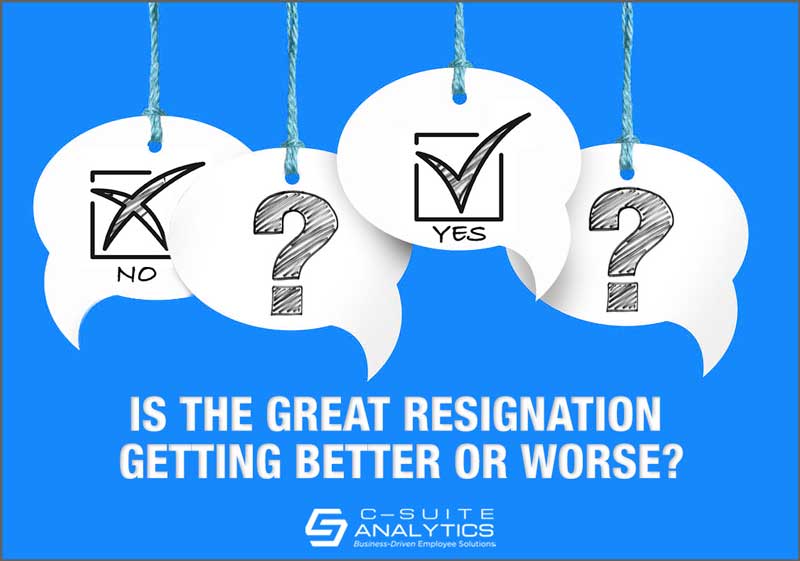Most hiring tools answer whether candidates can and will do the job, but not if they’ll stay. Learn how realistic job previews and motivational-fit interviews can improve retention from day one.
Is The Great Resignation Getting Better or Worse?

Look at the Data to Track The Great Resignation
We track two numbers month-to-month, how many workers are voluntarily quitting and how many jobs are open. These are the numbers that shout headlines regarding where our nation is heading regarding turnover…and our ability to improve it with retention. And the one-word answer to the above question is worse.
| Voluntary Quits | Job Openings | |
| 2021 | 32.5% | 10,925,000 |
| Annualized 2022 | 34.8% | 11,549,000 |
| % Growth | 7% | 5.7% |
This data is from the Bureau of Labor Statistics…or BLS…and the annualized 2022 data is based on first quarter results. The data hammers home that economists’ predictions that offer zero optimism for a fast end to The Great Resignation are spot on. Here are a few of those predictions that have been reported previously here, both first published in the fourth quarter of 2021:
First from the Wall Street Journal: “Many expect the labor shortage to last at least several more years, and some say it’s permanent. Of 52 economists surveyed by The Wall Street Journal, 22 predicted that participation would never return to its pre-pandemic level.”
And from Time Magazine: “Economists predict that the Great Resignation is only getting started, especially for Gen Z and millennial workers who are well positioned to find new ways to earn income.”
Then about two months ago I told you about another economic think tank’s prediction that included this shocking headline:
“If immigration does not improve…I’m not sure how we get back to growth.”
That report went on to say that our economy could not sustain itself without opening our borders to many additional workers. And in fact that inflation and supply chain issues, the ones most economists say are today’s top economic worries, are both caused at their base by too few workers. If you missed that report, I suggest you revisit our blog featuring it.
Demographics and The Great Resignation
Most reporting on causes of The Great Resignation miss the mark. Journalists tell us profiles of workers who re-established their life priorities during the pandemic. One that comes to mind is a healthcare professional who decided his top priority was taking his daughters to soccer practice and that no traditional job would permit him to do that. So he quit his job, started a consulting business, and is happier for having done so. Other stories talk about the impact of working from home, hybrid work, or even working from the back of one’s truck.
But the bigger story is about demographics because hard data about the actual number of Americans who are available for work cannot change. The U.S. birthrate has fallen for the past 70 years, and 2021 resulted in the lowest birthrate in U.S. history. When I was a kid my friends had multiple siblings but that is rarely so today. Most American families have two children, one, or none.
Here’s a stunning image. Economists tell us our current decade offers the smallest growth of workers in our nation’s history outside of the period immediately following the civil war. The current decade’s data is because so many baby boomers are leaving the workforce and the continuing birthrate decline presents us with a dwindling number of replacements. And looking way back, how many children could there have been in the late 1800s after 600,000 potential fathers were killed during the civil war?
Data like this put the brakes on optimism, on believing that The Great Resignation is a fad because young workers will wise up, need more money, and return to the traditional workforce. The much bigger story is our nation just does not have enough workers to fill all of our jobs.
Immigration and The Great Resignation
How would our politicians react to the above-noted suggestion that we open the doors to immigration? And related to immigration, one study reports the number of foreign workers who are applying for HB-1 visas is down by over a million applicants because those who might have previously applied don’t care for the “political climate” of our country. These include the doctors and scientists who as just example Silicon Valley employers sponsor to bring specific professional talents into our country.
Someone out there please tell us a joke because we need some levity to deal with this news.
Jokes won’t solve turnover though. But being serious about cutting turnover requires putting a cost on turnover, establishing retention goals, conducting Stay Interviews and forecasting, and then holding leaders accountable to goals and forecasts. This is the method that has been proven to do so both before and during The Great Resignation.
You Can Cut Turnover Even During The Great Resignation
Schedule a conversation with me at DFinnegan@C-SuiteAnalytics.com to discuss your employee retention roadblocks and I’ll share ideas for how you can move forward and what is working for other companies to cut turnover by 20% and more, even during The Great Resignation that may benefit you.



